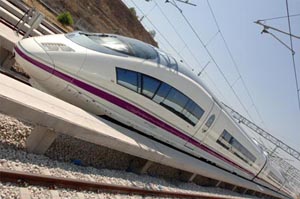The trains in Spain compete against the planes

What a contrast. While the British government spends billions of pounds widening motorways and tries to expand airports, the Spanish government has been investing in high-speed rail.
Spain is preparing itself for a future in which there may be limits on the number of flights a person is allowed to take, and has focused on the need to reduce domestic flights. The latest project focuses on journeys between Barcelona and Madrid; the solution is the 220mph Ave S103, a fancy train which carries 404 passengers on chairs which swivel so you're always facing forwards.
The Spanish government spent £15.7bn in its first term of office, as part of a 15-year €108bn project which aims to have 6,200 miles of high-speed track in Spain by 2020. This will put 90% of the population within 30 miles of a high-speed rail station - a far cry from Labour's obsfucation of plans for a north-south high-speed line.
The Spanish government's plans are wide ranging and extrememly popular. In December lines connecting Madrid to Valladolid and to Málaga opened, slashing journey times. Aberlado Carrillo, the director general of the state rail operator Renfe's high-speed service, described the success of these two lines as "unprecedented and well ahead of what we expected. Traffic has doubled on the Málaga line, and grown by 75% on the Valladolid line."
Iberia airlines, which runs an air-shuttle link between Madrid and Barcelona, says it welcomes the fight from the Ave. The Iberian service is still faster, but, says Carrillo "Time spent in a train is time won, while in a plane it is wasted. In a train you can work, read, talk, use the internet, eat, or simply relax and enjoy the journey. With a plane, the only objective is to arrive."
Want to travel around Europe without flying? Visit Seat61.com and discover how!


